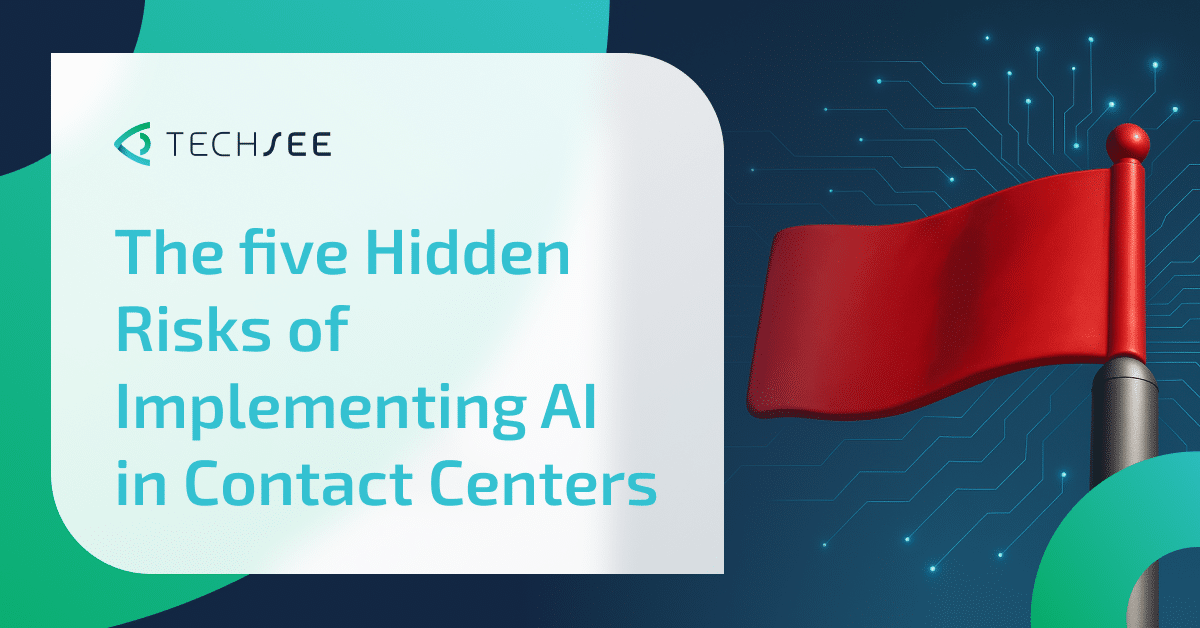Contents
- The five Hidden Risks of Implementing AI in Contact Centers
- 1. The Human Factor: When AI Adds Pressure Instead of Reducing It
- 2. Cost Risk: When ROI Turns into Runaway Complexity
- 3. The Blind Spot: When AI Can’t See What the Customer Sees
- 4. The Learning Plateau: When AI Stops Getting Smarter
- 5. The ROI Illusion: When Short-Term Metrics Hide Long-Term Costs
- Conclusion
- FAQ: AI Risks in Call Centers
The five Hidden Risks of Implementing AI in Contact Centers
Across the industry, contact center leaders are investing heavily in AI, from chatbots to cognitive agent-assist systems, to improve efficiency and customer satisfaction. Yet adoption often falls short of expectations. According to research, nearly 95 percent of enterprises report that their AI projects fail to deliver measurable ROI.
The problem rarely lies in the algorithm. The true risks of implementing AI are operational: how it’s introduced, integrated, and measured. Based on hundreds of conversations with leading service organizations, five risk areas stand out.
Recognizing them early can make the difference between a short-lived pilot and a sustainable transformation. In this article, we will discuss the five hidden AI risks in contact centers in detail.
1. The Human Factor: When AI Adds Pressure Instead of Reducing It
Contact centers are under pressure to modernize fast, often deploying multiple AI tools within short timeframes. This pace of change can overwhelm frontline teams. Agents are expected to follow new prompts, learn new interfaces, and adapt to new workflows, all while meeting existing KPIs. The result is change fatigue: employees lose confidence, engagement drops, and adoption plateaus.
At the same time, heavy reliance on AI recommendations can weaken core diagnostic skills. When systems provide every next step, agents gradually lose their ability to reason independently through complex issues. Over time, this erodes the organization’s ability to handle exceptions precisely where human judgment matters most.
Leaders should view AI as an augmentation strategy, not a substitution strategy. Involving agents in the design process, rethinking training to emphasize reasoning with AI, and aligning incentives around collaboration rather than compliance can prevent burnout. It also preserves critical skills.
Takeaway: AI succeeds when people see it as an ally. The biggest risk is implementing technology faster than humans can adapt to it.
2. Cost Risk: When ROI Turns into Runaway Complexity
AI is often introduced as a cost-saving initiative, but contact centers frequently underestimate the total cost of ownership. Projects that begin as pilot deployments often expand into complex ecosystems of models, integrations, and governance layers.
Hidden expenses, such as model maintenance, API costs, and training data management, can accumulate quickly. Integration with CRM, ERP, and CCaaS platforms introduces additional dependencies that demand ongoing support. In Deloitte’s 2024 AI Implementation Benchmark, 53 percent of executives cited “unanticipated integration complexity” as their top challenge in managing AI budgets.
Effective financial governance requires looking beyond early efficiency metrics like handle time or containment. Leaders must calculate end-to-end economics, including maintenance, retraining, and human oversight. Only then can ROI reflect the full lifecycle cost of cognitive agent assist solutions.
Takeaway: AI cost savings can evaporate without governance. Measure success across the lifecycle, not just at launch.
3. The Blind Spot: When AI Can’t See What the Customer Sees
Traditional call center agent-assist solutions rely solely on text and voice, leaving AI blind to what matters most: the customer’s environment. Many of the highest-cost service issues, such as connectivity failures, misaligned sensors, and hardware installation errors, are visually apparent. Without visibility, AI can only infer the problem from what the customer describes.
That gap is costly. TechSee data shows that visual AI can reduce truck rolls by up to 20 percent and cut average handle time by 30 percent, simply by letting agents see what the customer sees. When AI can process visual cues, it understands the full situation: where devices are placed, which lights are flashing, and what the customer is actually facing.
Without that capability, organizations risk building “partial intelligence” systems that sound smart but still rely on trial and error. Adding visual context converts assumptions into evidence. Plus, it helps contact center agents and assist tools deliver real precision instead of educated guesses.
Takeaway: Every contact center has a visibility problem. Solving it turns AI from reactive support into proactive resolution.
4. The Learning Plateau: When AI Stops Getting Smarter
Many AI initiatives start strong but plateau within months. Models stop improving because they learn from limited data, usually transcripts or chat logs. They miss valuable feedback from agents, visual interactions, and field results. When learning loops are incomplete, AI repeats old mistakes.
A cognitive agent-assist platform should continuously integrate insights from every touchpoint: self-service, live-agent interactions, and field visits. If an agent overrides a wrong recommendation or a technician discovers the real cause of failure, those signals must feed back into the model. Without this loop, AI becomes static and irrelevant.
In one global telecom deployment, integrating agent feedback into AI recommendations improved accuracy by 18 percent in three months, while reducing false suggestions by nearly half. This shows that progress comes not from having more data, but from connected data, the kind that links what was said, seen, and resolved.
Takeaway: AI performance declines when learning ends at the contact center boundary. Continuous improvement depends on connecting insights across channels and roles.
5. The ROI Illusion: When Short-Term Metrics Hide Long-Term Costs
Nearly every AI project begins with a cost target: shorter handle time, higher containment, or reduced headcount. But these metrics often hide the full picture. Reducing call center costs with AI is about building sustainable efficiency across the customer journey.
Reducing calls may look like success until repeat contacts or technician visits rise. Cutting average handle time means little if customer trust erodes. The real value of AI lies in the total cost per resolution and long-term experience gains. When automation, visual tools, and field checks work together as a single system, the savings add up rather than just moving between departments.
True ROI also includes softer metrics: lower agent attrition, higher customer satisfaction, and faster onboarding for new hires. These may not show up in the first quarterly report, but they determine whether an AI investment becomes self-sustaining.
Takeaway: The smartest contact centers measure AI’s efficiency by how consistently it prevents cost, effort, and churn over time.
Conclusion
Implementing AI in contact centers is no longer about whether to do it; it’s about doing it right. The risks are rarely in the algorithms but in the design, integration, and human experience around them. When organizations treat AI as a tool that augments judgment rather than replaces it, the benefits multiply: faster resolutions, lower costs, and happier agents and customers.
The next stage of cognitive agent assist will belong to the companies that build visibility, feedback, and trust into every interaction. It’s because seeing the problem clearly is always the first step toward solving it.
FAQ: AI Risks in Call Centers
1. What is the most common risk when implementing AI in contact centers?
The main risk is assuming AI will automatically reduce the workload. Without redesigning workflows, agent assist can actually increase stress and slow performance.
2. How can AI avoid creating new blind spots?
Combine voice, text, and visual data so the system understands the customer’s situation, not just what they say.
3. Why do AI systems stop improving after launch?
Most lack connected learning loops. Feeding insights from agents and field outcomes back into the model keeps recommendations relevant and accurate.
4. How should ROI be measured for AI in call centers?
Look beyond handle time and containment. Track total cost per resolution, repeat contacts, and technician dispatches to capture full-journey efficiency.
5. What distinguishes cognitive agent assist from traditional tools?
Cognitive systems combine visual, conversational, and contextual data, enabling AI agents to see, understand, and resolve issues faster and more confidently.






